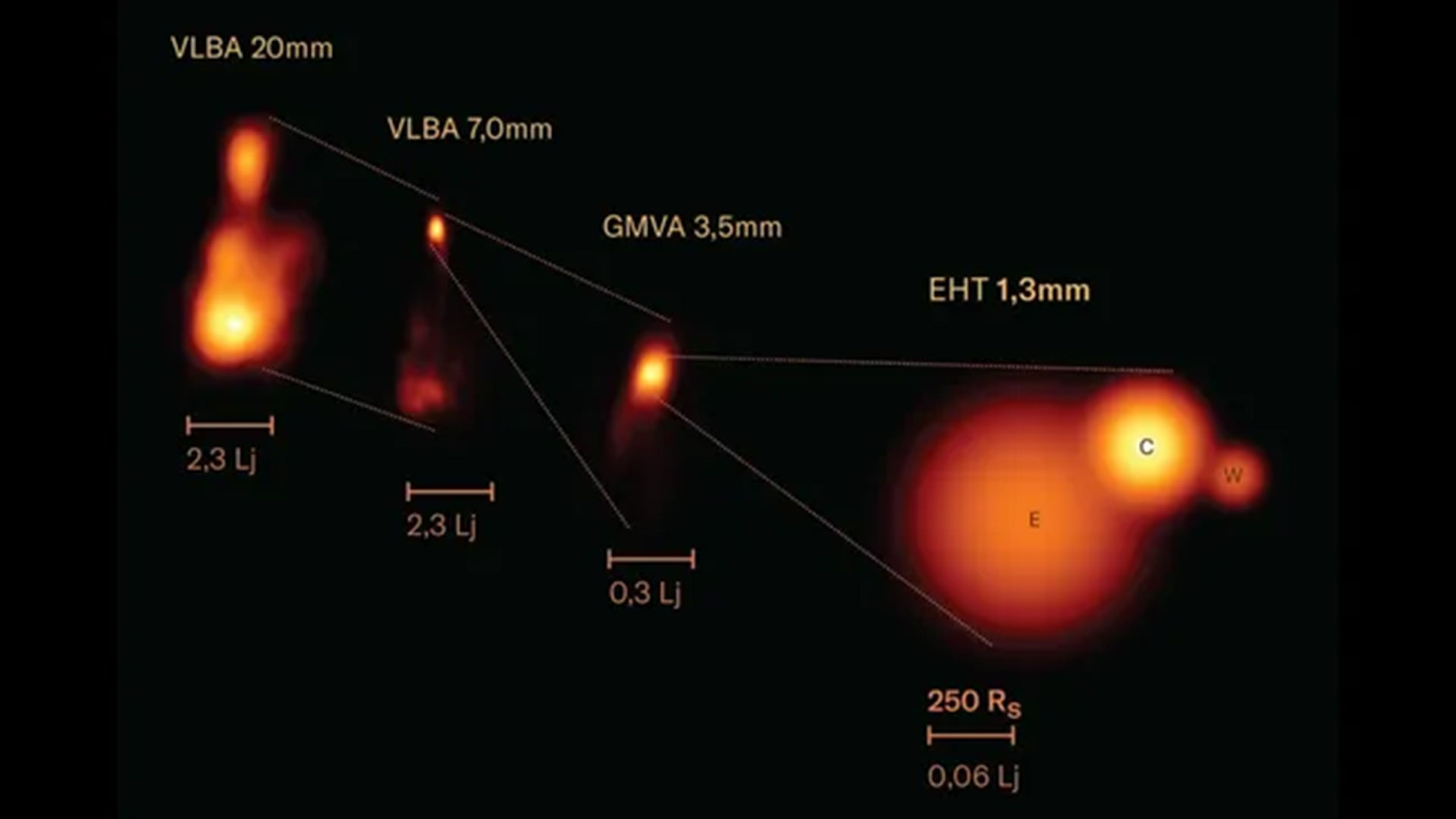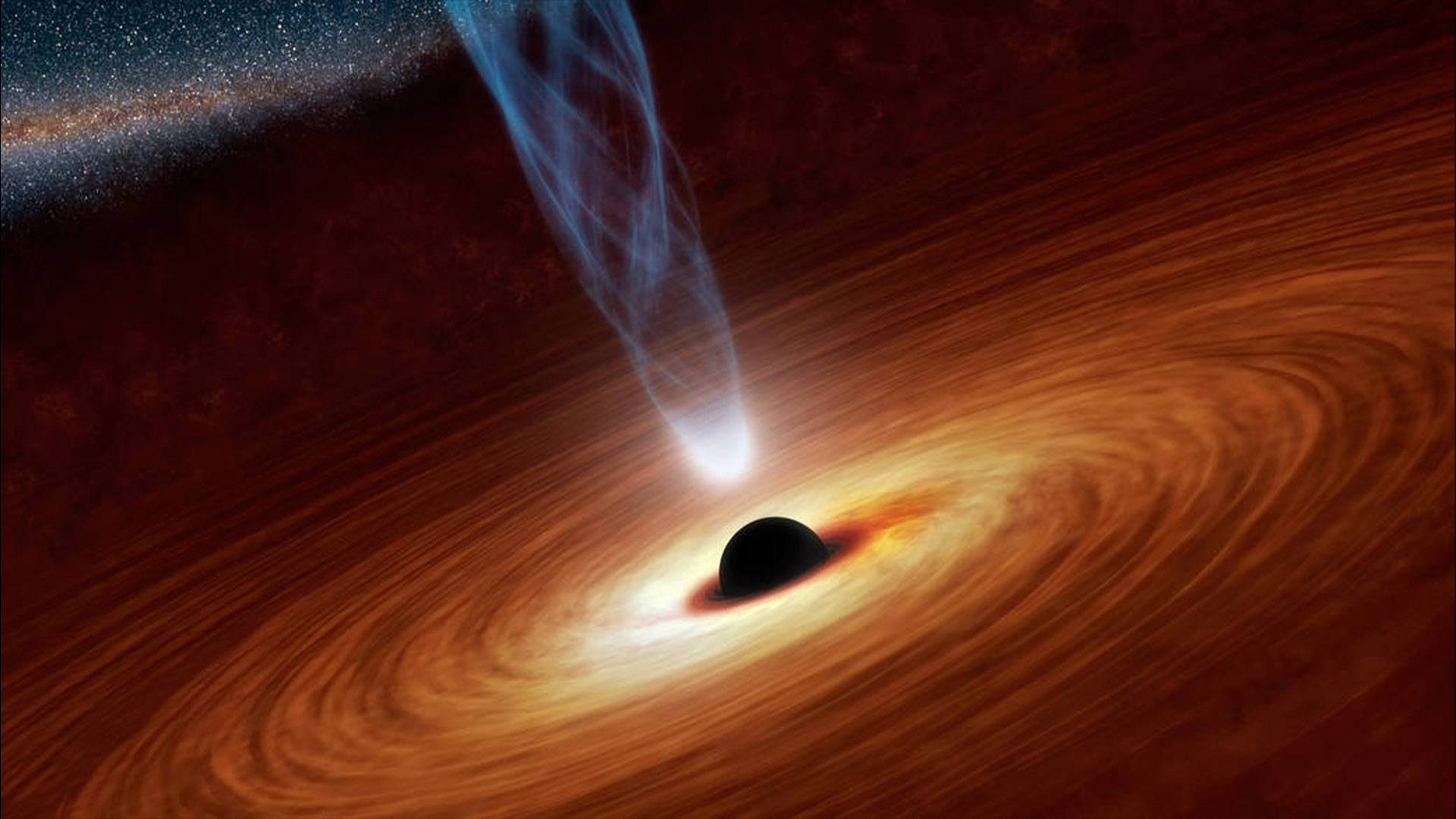Event Horizon Telescope spies gargantuan energy jets erupting from nearby supermassive black hole
Astronomers investigated an active supermassive black hole at the heart of Perseus A using the Event Horizon Telescope, spotting an epic battle between gravity and magnetism.

Astronomers have observed a supermassive black hole in Earth's cosmic backyard as it blasts out jets of matter at near-light speeds. These outflows tell the tale of a battle for supremacy between magnetism and gravity.
The discovery could help scientists better understand how black holes feed on matter and eject powerful jets that extend far beyond their host galaxies.
The team of astronomers made the observations of the heart of the radio galaxy 3C 84, also known as Perseus A, a region powered by a feeding supermassive black hole, using the Event Horizon Telescope (EHT). The EHT, a global array of linked-up radio dishes, produced the first images of a black hole ever seen by humanity.
Perseus A, a strong source of radio waves, corresponds with the center of the active galaxy NGC 1275, which itself is the central galaxy in the Perseus supercluster, which lies 230 million light-years from Earth. This sounds like a tremendous distance, but it makes the newly observed object one of the closest supermassive black holes to our planet.
Related: Right again, Einstein: New snapshot of 1st black hole to be photographed confirms relativity
"The radio galaxy 3C 84 is particularly interesting for the challenges it presents in detecting and accurately measuring the polarization of light near its black hole," study team member Jae-Young Kim, an associate professor of astrophysics at Kyungpook National University in South Korea, said in a statement. "The EHT's exceptional capability to penetrate the dense, interstellar gas marks a groundbreaking advancement for precisely observing the vicinity of black holes."
Magnetism vs. gravity: Which force wins?
The new Perseus A observations don't mark the first time that the EHT has investigated a supermassive black hole's powerful magnetism or gravity, two of the universe's four fundamental forces.
Get the world’s most fascinating discoveries delivered straight to your inbox.
After the telescope first imaged the supermassive black hole at the heart of the galaxy Messier 87 (M87), it also imaged the polarization of light around this black hole, which is as massive as 6.5 billion suns.
This work revealed details of the polarizing magnetic fields around M87's central black hole. And, in the new research, the EHT observed polarization around the Perseus A black hole, indicating a well-ordered magnetic field in its immediate vicinity.
These magnetic fields demonstrate their power by conquering the immense gravity of the radio galaxy 3C 84's black hole, estimated to have a mass 40 million times that of the sun, to launch jets at high speeds.
"Besides providing first images of black holes, the EHT is supremely suitable to observe astrophysical jets of plasma and their interplay with strong magnetic fields," said team leader Georgios Filippos Paraschos, of the Max Planck Institute for Radio Astronomy (MPIfR) in Germany. "Our new findings provide new evidence that an ordered magnetic field extends throughout the heated gas enveloping the black hole."
As matter falls toward the black hole, it forms an "accretion disk" around the object that is strongly magnetized. As this disk turns, the magnetic field lines within it twist, becoming tightly wound, which prevents magnetic energy from being released efficiently.
The EHT observations of the rapidly rotating Perseus A supermassive black hole and its surrounding "magnetically arrested disk" suggest that the speed at which a black hole rotates could be associated with its ability to launch jets.
This means that, while these jets represent magnetism winning out over gravity, they could be getting assistance in the form of "outside interference" from angular momentum. A deeper investigation and the application of Einstein's 1915 theory of gravity, general relativity, may help determine if this is the case.
"Why are black holes so good at producing powerful jets? This is one of the most fascinating questions in astrophysics," said MPIfR researcher Maciek Wielgus. "We expect that general relativistic effects occurring just above the black hole's event horizon may be the key to answering this question. Such high-resolution observations are finally paving the way towards an observational verification."
The EHT was able to make its in-depth observations of this black hole and its jets using a technique called very-long-baseline interferometry (VLBI), which allows an image to be created by collating signals from numerous telescope observations of the same object. The EHT consists of an array of individual telescopes across the globe that come together to make a single Earth-sized instrument.
"We are extremely excited, because these results are a significant step towards understanding galaxies such as 3C 84," said Anton Zensus, director of the MPIfR and head of its Radio Astronomy/VLBI research department. "Together with our international partners, we are striving to improve the capabilities of the Event Horizon Telescope to enable even more detailed insight on jet formation around black holes."
The team's research was published online Thursday (Feb. 1) in the journal Astronomy and Astrophysics.
Originally posted on Space.com.
Robert Lea is a science journalist in the U.K. who specializes in science, space, physics, astronomy, astrophysics, cosmology, quantum mechanics and technology. Rob's articles have been published in Physics World, New Scientist, Astronomy Magazine, All About Space and ZME Science. He also writes about science communication for Elsevier and the European Journal of Physics. Rob holds a bachelor of science degree in physics and astronomy from the U.K.’s Open University




